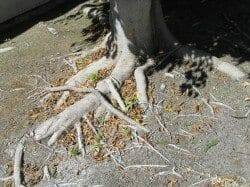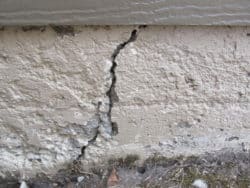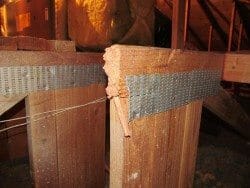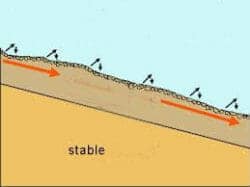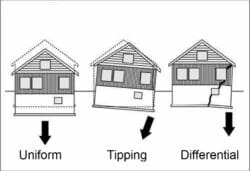Wavy or Sagging Roof May Be a Foundation Problem: 5 Things to Check
Home » Structural »
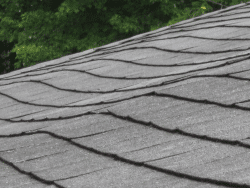
Wavy or sagging roofs can be a warning sign that there are foundation problems with a house, however there are a number of other reasons for a roof to sag or be wavy as well. When a homes foundation shifts, is not level or damaged, then the foundation issues may be reflected by a sagging, bowed or wavy roof.
Check foundation for these 5 things:
- Settlement and heaving
- Foundation levelness
- Cracked or damaged foundation
- Tree roots and subsidence
- Drainage or undercutting of the foundation
1. Settling and heaving
Homes that are built on poor or shifting soils will tend to move or settle somewhat. New home tend to settle a little in the first year or two and the older a home gets the more likely hood that it may incur settlement. If the foundation moves, but not equally in all places, the roof may reflect this; especially if there is differential settlement.
Where there are expansive type of soils, i.e. those with a clayey content, there is a high probability that when the soil gets wet, it will swell up or heave up which then affects the roof line, especially if the movement is not uniform. As the soils dry out the foundation may shift back downward , but not the same amount in all locations, thus the roof changes.
2. Checking the foundation for levelness
Foundations or foundation and slabs ideally should be level, however many are not: some were constructed that way when the home was built and some have moved or shifted after the home was built. They may tilt over time, but remain flat although they’re not level. If two people pick up a kitchen table and one raises his end higher than the other person, the table will still be flat but not level. Other foundations and slabs may bow or develop a concave or convex shape; at times just in one area of the home or the entire home.

One indication that a foundation is not level is that the floors slope. If you lay a golf ball on the floor and it starts rolling, then it’s an indication that the floor tilts or slopes. The faster the ball rolls, the greater the slope in most cases.
Another indication that the foundation is not level is that some of the doors in the home are self closing or self opening. When the foundation becomes out of level, then the door jamb is probably no longer plumb and this will cause the door to self close or open.
3. Cracks or damage
Foundations that are cracked or damage may have moved or shifted. When this movement is sufficient enough, it can result in the structure sitting on the foundation to have some sagging, a hump or bowed roof in a few cases. It is not unusual for a foundation to crack and little damage results from the cracking, however if the cracking or damage is significant, then the roof can be affected.
If the foundation has a crack or cracks where the top of the crack is wider than the bottom of the crack which you could call “V” shaped in nature, then it’s more of a concern. An example would be where the top of the crack is a half or three eighths of an inch wide and the bottom of the crack is a sixteenth or eighth of an inch wide.
Another level up might be where the foundation is cracked and one side of the crack is offset from the other side of the foundation. This may be an indication that the foundation is rotating.
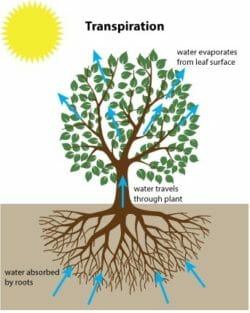
4. Tree roots and subsidence
Homes that have trees near the foundation may actually have foundation issues that will affect the roof. Generally we think that roof damage comes from trees or branches rubbing or falling onto the roof, which is a common occurrence, however we seldom think that occasionally the roots may result in roof damage. I know you are thinking how can this be.
Trees are always seeking water and nutrition to grow and they achieve this mostly through gathering moisture and nutrition through their roots. Much of this moisture works its way up the trunk and and then changes to vapor and is released through the leaves into the atmosphere; a process known as transpiration. Trees that are near a homes’ foundation or have root systems that reach out great distances may draw moisture from the foundation area, including the area under the foundation.
In expansive types of soils, when the tree roots draw moisture from the soil, the soil particles shrink or get closer together. As the soil particles shrink, the dirt under the footings drops down due to the shrinking. This usually results in the foundation dropping down or moving and this movement may occasionally result in roof issues such as humps, sagging or waviness. The greater the soil movement, the more likely hood of roof issues.
5. Drainage or undercutting of the foundation
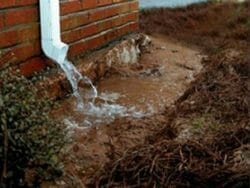
Another cause of foundation movement, which we know by now, will occasionally affect the roof, is undercutting and poor drainage.
Undercutting of a foundation relates to water basically washing away part of the soil supporting the foundation, some refer to it as erosion of the soil. Causes of undercutting includes:
- Broken water line near the foundation or under it
- Damaged or leaking sewer line
- Flooding of the home or its foundation
- A stream, creak or river eating away at the soil near or under the foundation
Poor drainage may likewise affect expansive soils or cause erosion. Checking where your gutters and downspouts discharge, so that it’s not too close to the foundation is wise, as well as checking whether the neighbor is draining his excess water over onto your property and whether it’s affecting your foundation.
Non-foundation causes of sagging, waviness or humps include:
Two or more roofs
Two or more roof coverings where one has been laid on top of another rather than remove the old roof first. I.e. the house had composition / asphalt shingles and was re-roofed without removing the old roof first. The extra weight of the second roof may cause sagging or waviness. ( Read more on two or more roof coverings )
A new roof that is of a heavier material
If the original roof was wood shingles ( a light weight material) and it was replaced with concrete tile (a heavy material), then the roof may sag or be wavy because it was not structurally designed to carry the heavier load (weight).
Cracked or damaged rafters or trusses
Wood rafters or trusses, if cracked or damaged, may result in the roof being wavy or sagging. Should one or more trusses or rafters be cracked and they are next to one another, then the roof may sag in that area. If possible check the rafters or attic area for damage evidence. Remember that damage from termites or water damage from leaks will also weaken a truss or rafter, as well the roof sheeting. ( A checklist of 6 things to check in the attic )
Earthquakes
Earthquakes are extremely powerful and can put tremendous forces on roofs. These forces may cause a roof to sag, bow or even collapse in a few instances. Additionally, the shaking and soil movement may cause the foundation to shift or settle, resulting in roof damage or sagging.
Improper design or engineering
Occasionally the the engineering of the roof is not correct for the load that will be on the roof. If a heavier tile is used than the roof is engineered for or there is a heavy air conditioning united placed on the roof, then sagging or bowing may occur.
Poor workmanship
When the walls and roof of a home are framed, there is a tendency for everyone to be in a hurry and because of this, there is not as much attention to detail as there should be. The carpenters may not take the time to make sure that everything is straight, not bowed and that there are no areas that have a hump.
Bottom line
If the foundation shifts, moves or bows, then this movement may cause the roof to have a hump, sag or be wavy. Although foundation issues may affect the roof there are also a number of other reasons that roofs may sag or become wavy. Even if a roof is a little wavy it doesn’t necessarily mean the roof is going to leak or to structurally fail, so it’s wise to look at the severity of the waviness or sagging and look at the house as a whole while checking other components before becoming overly concerned.

Articles and Resources On Common Structural Issues In Homes
Take a minute and review the list to see if you have any warning signs of potential issues.
- You may only need preventive maintenance
- If very minor, then maybe you just need to monitor it
- If repair is needed, it is much cheaper to correct in the early stages than after it has become a big problem
- Should it be major, then you may need to consult a qualified professional
